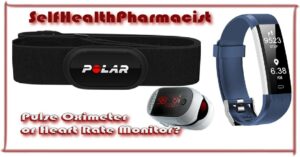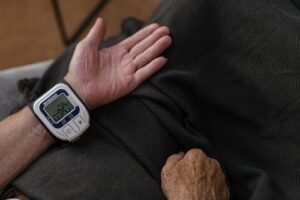Often, for effective treatment, not only medicines are needed, but also medical equipment.
And in our time, some procedures that were previously carried out only in the clinic can be done independently, without leaving home.
For example, measure blood pressure, glucose or oxygen levels, pulse in the blood…
A wide range of products for monitoring the health of uninformed people can simply be confusing.
Many people often confuse devices that are consonant in name, in particular heart rate monitors and pulse oximeters.
However, with similar names, they have different purposes and functionality.
What is the difference between them?
Let’s try to figure this out.
Looking for The Best Pulse Oximeter?
Let me tell you about the Wellue O2Ring – it’s like the superhero of pulse oximeters, seriously!
One of the coolest things about it is that it doesn’t just clip onto your finger like your average oximeter.
Nope, it’s a smart ring that you wear on your finger, making it super comfortable and convenient. You won’t even feel like you’re wearing anything special, yet it’s working its magic behind the scenes.
What sets the Wellue O2Ring apart from the pack is its continuous monitoring feature.
Most pulse oximeters just give you a snapshot of your oxygen saturation and heart rate, but this bad boy keeps tabs on your levels around the clock.
Whether you’re chilling on the couch, out for a jog, or catching those Z’s, it’s right there with you, providing real-time data.
Oh, and speaking of data, this thing doesn’t just show you numbers – it visualizes your trends over time too.
Imagine having a personal health diary that tells you when you’re acing life and when you might need to take it easy. It’s like having a health-conscious buddy right on your finger!
If you’re already itching to get your hands on the Wellue O2Ring (or, well, your finger in this case), I’ve got you covered.
Check out their official product page here.
Table of Contents
Pulse Oximeter Vs Heart Rate Monitor Difference
| Pulse Oximeter | Heart Rate Monitor | |
| What is this? | This is a device that measures not only the pulse, but also the concentration of oxygen in the blood – blood saturation. | A heart rate monitor is a small device designed to measure a person’s pulse (frequency of contraction of the heart muscle) in various conditions.
This device is used to monitor the operation of the cardiovascular system and analyze its functionality in medical research. Heart rate monitors are widely used in sports, fitness and cardio training. The result of training directly depends on the heart rate. |
| Why do we need it? | The heart makes the lungs work and oxygen enters the body through them, and the circulatory system already carries it to other organs.
If there is not enough oxygen to the organs, then they begin to work worse and serious problems arise. To monitor the level of oxygen in blood hemoglobin (hemoglobin is the oxygen carrier), there is a special device – a pulse oximeter. Its professional name is a heart rate oximeter, which emphasizes that it measures two indicators – pulse and blood oxygen saturation (saturation). This device can be used both for single measurement, and for continuous control, as well as long-term monitoring. Its main advantage is the speed of measurement. For the study, there is no need for blood sampling, which greatly simplifies the task of the doctor-diagnostic. It can be used even if the patient is unconscious, the device, in spite of everything, displays the received, processed data. |
Depending on the model, devices may have the following health monitoring functions:
• Measure the number of calories burned; • Calculate the value of the maximum, as well as the average heart rate; • Shows an indication of fat burning… |

The work Principle of Pulse Oximeter vs Heart Rate Monitor
| Pulse Oximeter | Heart Rate Monitor | |
| What does it consist of? | The pulse oximeter consists of a sensor designed to collect readings, a microprocessor that processes the readings, and a display that shows the measurement result.
The sensor of the device, fixed on the finger, earlobe or wing of the nose, has two LEDs: red and infrared. |
Modern heart rate monitors usually consist of two elements: a chest strap sensor and a wrist receiver, a GPS navigator or a mobile phone.
Usually, to obtain good contact, the sensor electrodes are wetted with water or a special gel. |
| What is the work principle of a pulse oximeter? | Any pulse oximeter has a peripheral sensor, a microprocessor, and a display that shows the pulse curve and its frequency, as well as the saturation indicator.
The devices are equipped with a sound signal that reflects the level of saturation, and the sensor has two LEDs, most often superimposed on the finger and less often on the earlobe or the wing of the nose. The most important condition for obtaining reliable data is the complete immobility of the finger during the measurement process. The norm for a person is a saturation index of 95-98%. The research method is highly informative. |
According to the method of obtaining information about the pulse, heart rate monitors are usually divided into chest heart rate monitors and optical sensors.
The latter are built into sports watches or fitness bracelets, as well as in the form of separate devices. An LED and a photocell are responsible for fixing the pulse. The first directs light into soft tissues, the second fixes the amount of blood in the vessels. The more blood, the less reflected light and vice versa. |
What are the best Options of Pulse Oximeter vs Heart Rate Monitor?
| Pulse Oximeter | Heart Rate Monitor | |
| What is the best Option? | The Wellue O2 Ring is the latest technology of pulse oximeters.
It is the best choice for overnight oxygen saturation monitoring and health monitoring. It has accurate tracking of all indicators and very common features such as oximetry Technologies, waterproof resistance, smart alarms and saturation alerts. The device is simple and reliable in operation so that it can be used at home without special technical and medical knowledge.
|
Heart rate monitor (pulse monitor) Polar H10
This premium heart rate monitoring strap transmits real-time heart rate data via ANT+ and Bluetooth Low Energy connections, giving you more options for indoor, outdoor or even online workouts. With it, you’ll be able to consistently get accurate heart rates on your device, as well as online workout apps like Zwift, Trainer Road, or even compatible fitness equipment in your gym. Choose any training method to get the accurate, real-time heart rate you need to improve your fitness. The Polar H10 features a padded strap that is comfortable and adjustable. Simply remove the heart rate module and the detachable strap is washable. Also, you don’t have to worry about battery life. Battery life up to 3.5 years. |
What are the categories of people who need Pulse Oximeter vs Heart Rate Monitor?

| Pulse Oximeter | Heart Rate Monitor | |
| What are the categories of people who need it? | Doctors recommend a pulse oximeter to patients with diseases of the respiratory and cardiovascular systems; it is also used by athletes who monitor blood oxygen saturation.
A person can catch the moment when he shows signs of respiratory failure. For example, with obstructive pulmonary disease, the risk of respiratory failure is high, but the patient himself cannot determine that he has become worse – he/she already has shortness of breath… |
Heart rate monitors are widely used in sports, fitness and cardio training.
The result of training directly depends on the heart rate.
|
How to use pulse oximeter vs Heart Rate Monitor?
| Pulse Oximeter | Heart Rate Monitor | |
| How to use? | The pulse oximeter has a peripheral sensor, a microprocessor, and a display that shows the pulse curve and its frequency, as well as the saturation indicator.
The devices are equipped with a sound signal that reflects the level of saturation, and the sensor has two LEDs, most often superimposed on the finger and less often on the earlobe or the wing of the nose. The most important condition for obtaining reliable data is the complete immobility of the finger during the measurement process. The norm for a person is a saturation index of 95-98%. The research method is highly informative. |
The vast majority of modern models of these devices differ in the principle of using…
They may be: • Chest – a belt with a sensor, worn in a girth under the chest; • Built-in – the sensor is built into the handles of the simulator and measures the heart rate by touching the hands with the electrodes, and the information is displayed on the panel; • With a pulsation sensor – sensors are fixed on the earlobe or fingers. Heart rate monitors of all types are divided into: wired and wireless. They differ in how they are worn: – Put on clothes; – Worn on the wrist; – Fixed on the simulator, bicycle, etc. |
So, Is a pulse oximeter the same as a heart rate monitor?
From all of the above, you can understand what is the difference between heart rate monitors and pulse oximeters.
Although both measure the pulse, there are significant functional and design differences and different areas of application.
In simple terms, heart rate monitors are more intended for healthy people involved in sports. Pulse oximeters are more commonly used by physicians or patients who require constant monitoring of arterial capillary hemoglobin oxygen saturation.
FAQ
How accurate are pulse oximeters for heart rate?
They are effective, they use an LED and a photocell are responsible for fixing the pulse. The first directs light into soft tissues, the second fixes the amount of blood in the vessels. The more blood, the less reflected light and vice versa. But for measuring heart rate I would suggest you choose a heart rate monitor...
What is the difference between pulse rate and SpO2?
Pulse – heart rate, that is, the number of heartbeats per minute and SpO2 means percentage of oxygen saturation.
Can a pulse oximeter detect an irregular heartbeat?
No. Blood Rate Monitor allows you to automatically detect violations of the heart rhythm, checks the reliability of the results and indicates the need for repeated measurements.
It allows you to automatically detect violations of the heart rhythm, checks the reliability of the results and indicates the need for repeated measurements.


